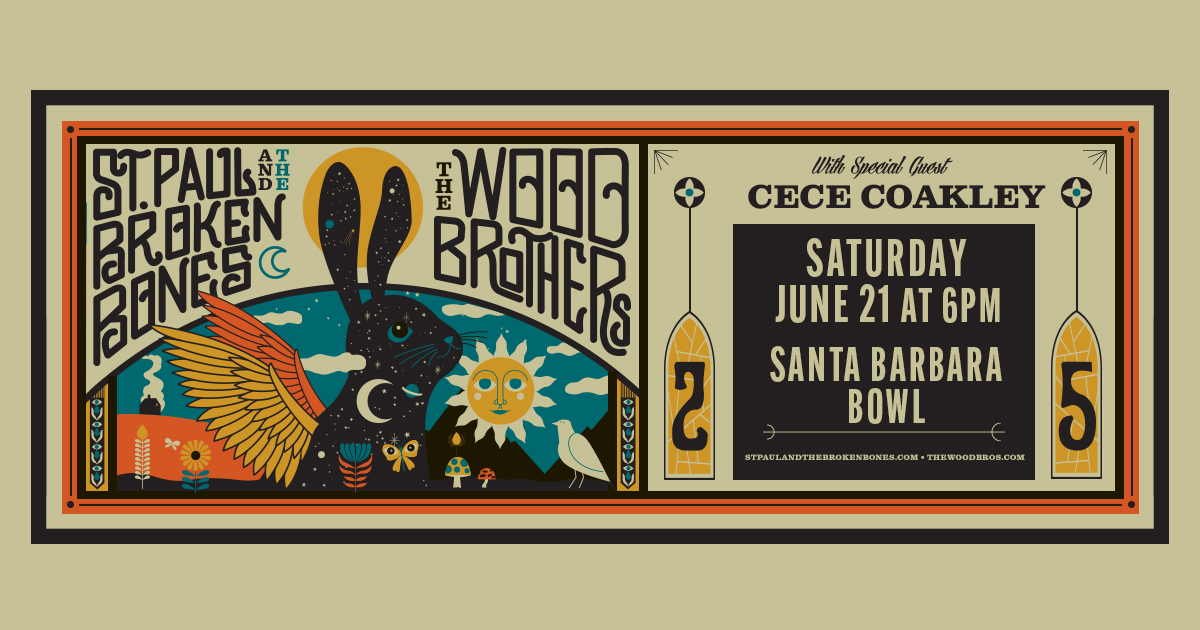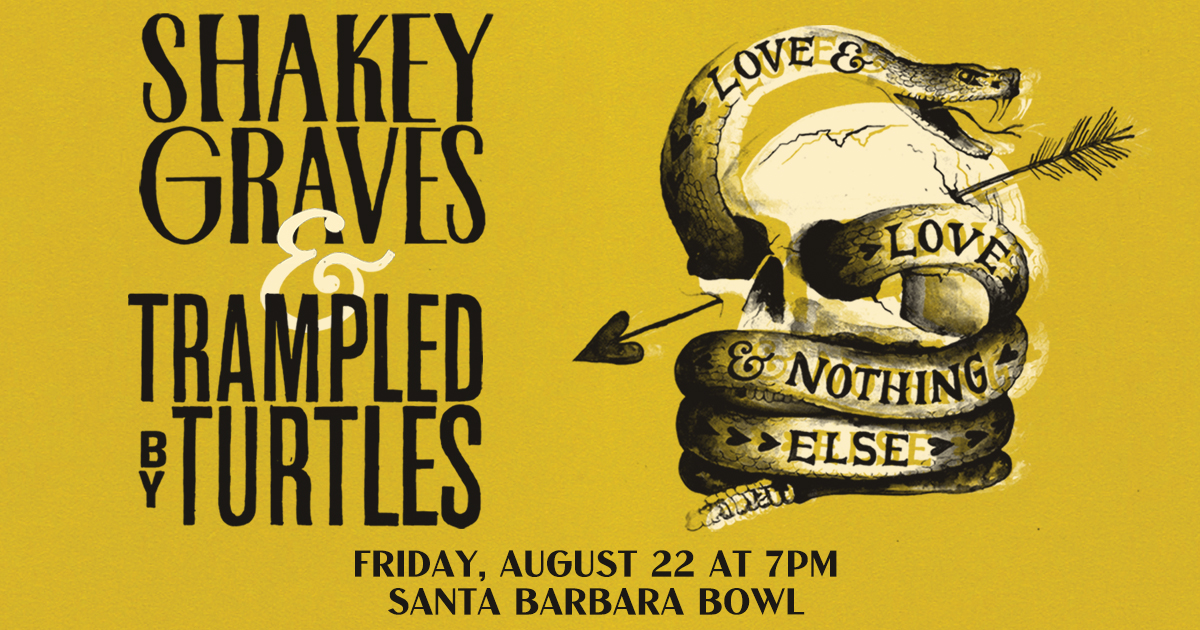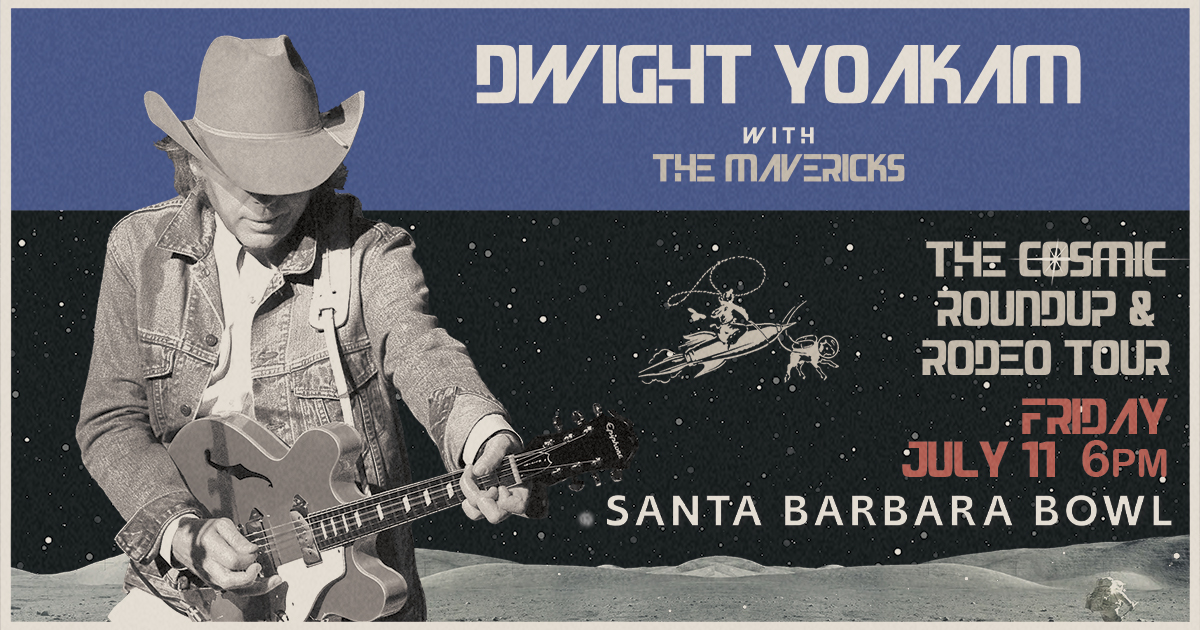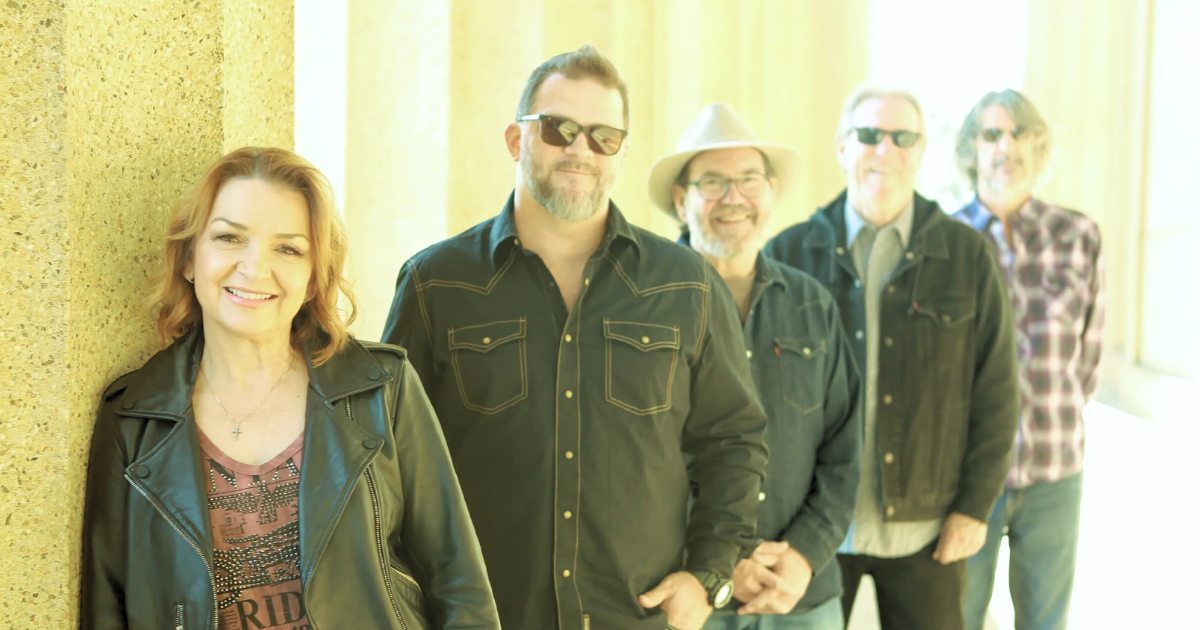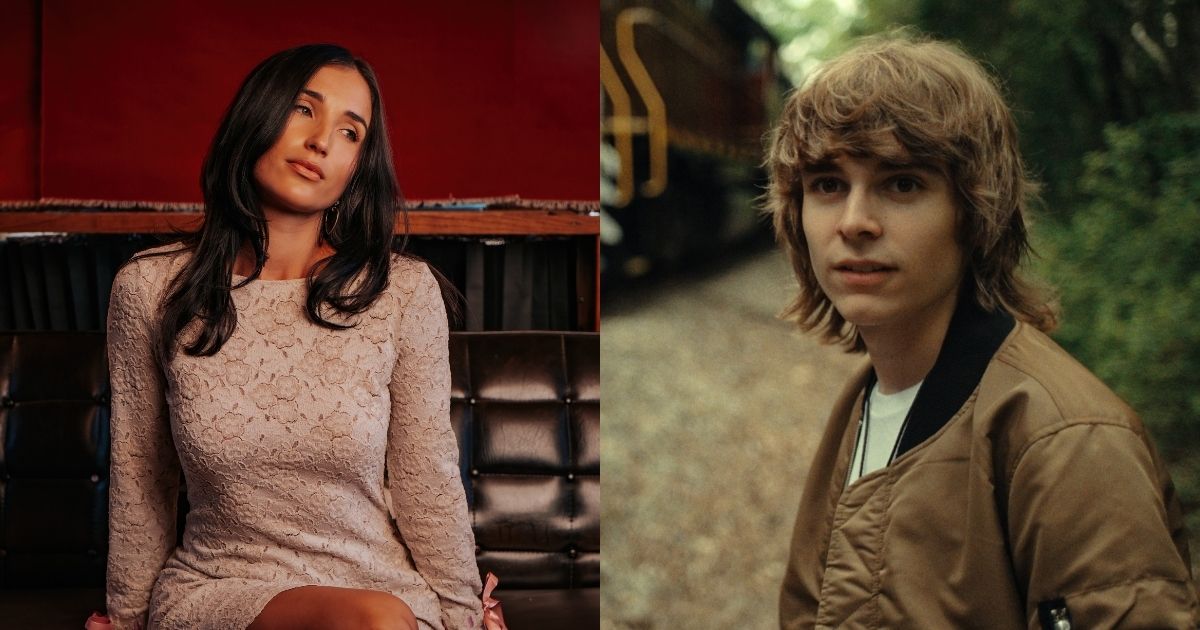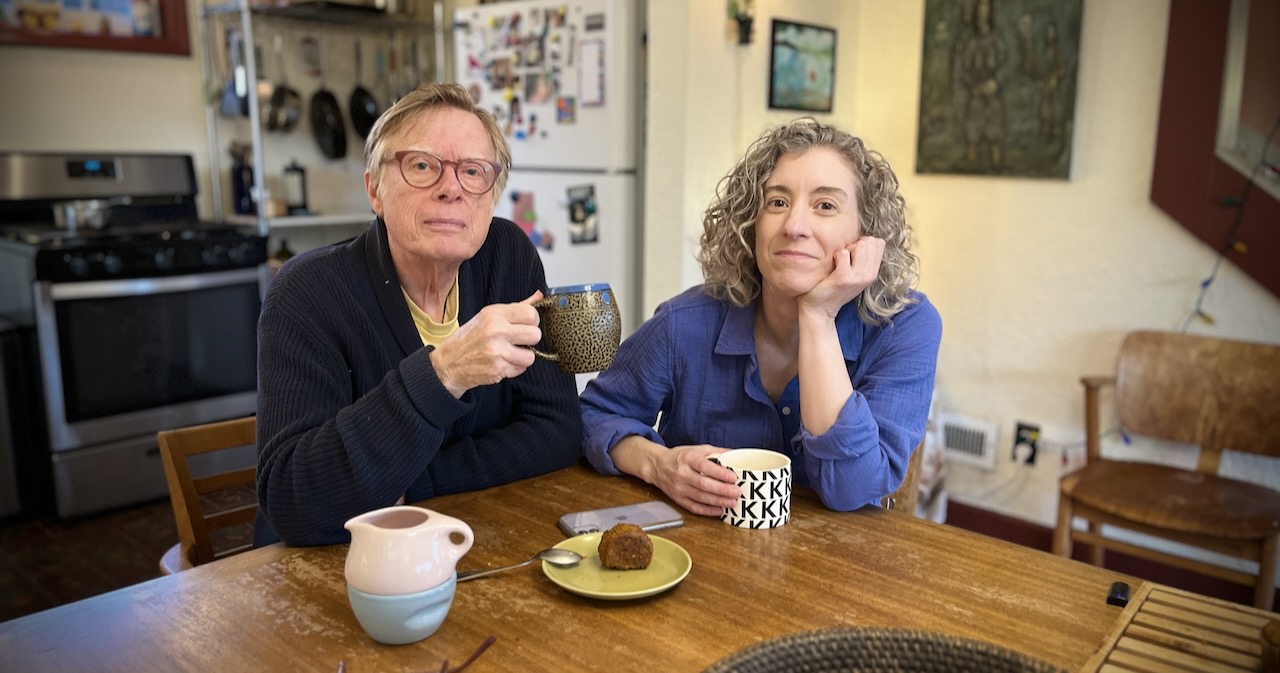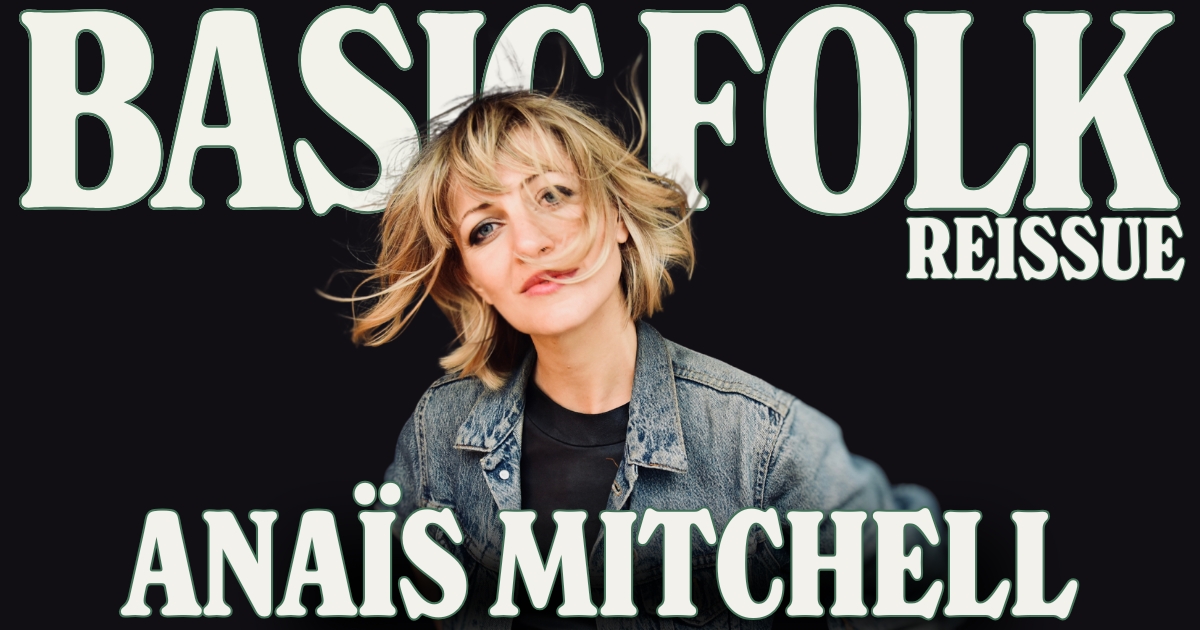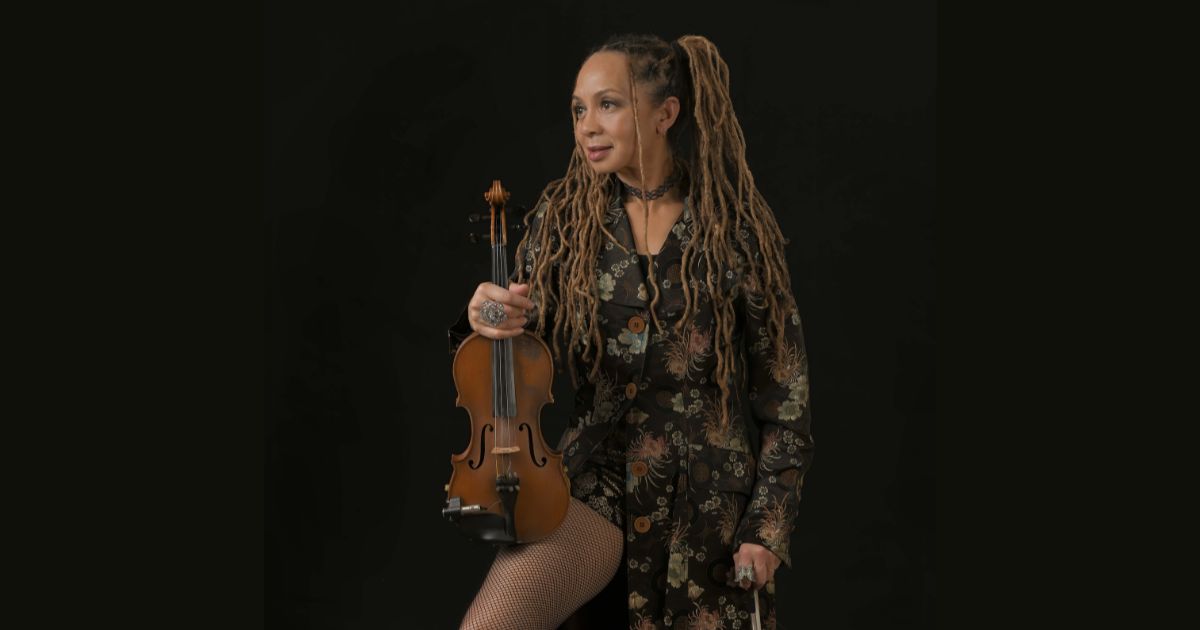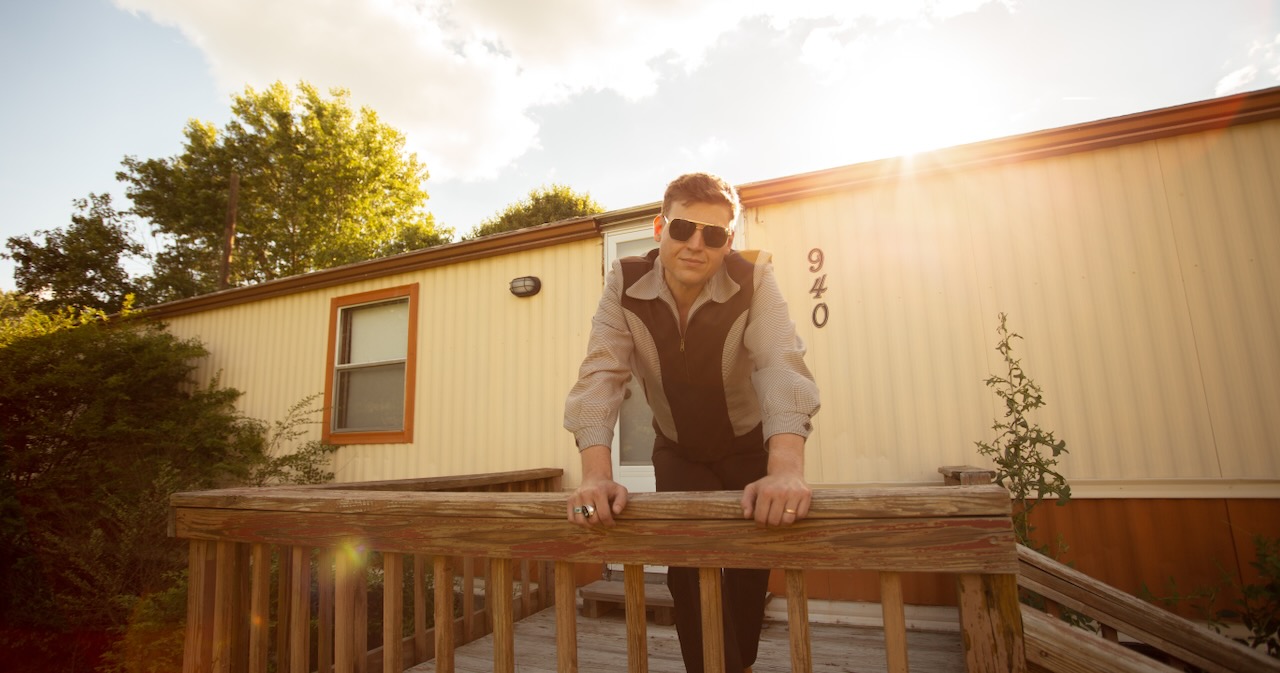GIVEAWAY: Enter to Win Tickets to Shakey Graves & Trampled By Turtles @ Santa Barbara Bowl (CA) on 8/22
GIVEAWAY: Enter to Win Tickets to Dwight Yoakam with The Mavericks @ Santa Barbara Bowl (CA) on 7/11
The SteelDrivers Celebrate 20 Years, Usher in New Chapter With ‘Outrun’
With four lead vocalists, seven studio albums, one GRAMMY Award to their name, and countless fans won over, The SteelDrivers have been one of this century’s most consistent and trailblazing bluegrass bands. That longevity can be credited to three things – the strength of their catalog of all-original songs, their collective precision picking, and the family atmosphere the band has cultivated together since forming in 2005.
Despite not joining forces until then, banjoist Richard Bailey says he’s known bandmates Tammy Rogers (fiddle) and Brent Truitt (mandolin from 2012 to present) since they were teenagers. His first run in with Mike Fleming (bass) and Mike Henderson (mandolin 2007 to 2011) came not long after during a college ski trip, with the group remaining close ever since. In the early 2000s Bailey relocated to Nashville from Memphis and reconnected with Henderson, regularly joining him at the Station Inn during Sunday night bluegrass jams and setting the foundation for what would eventually become The SteelDrivers. Then one day Henderson rang him up and was glowing about a young kid he’d just started writing with named Chris Stapleton who was wanting to play a little bluegrass.
“We eventually got together at his house and nobody knew Chris except for Henderson,” Bailey tells BGS. “We rehearsed a few bluegrass standards and then Chris began singing and Tammy, Mike, and I all looked at each other and went, ‘damn!’ I remember asking if the song he sang was an old Stanley Brothers tune and he said that it was actually one that he wrote.”
By that point, Henderson and Stapleton had already been penning songs together for a few years, with one of their most notable co-writes to that point being “Higher Than The Wall” from Patty Loveless on 2003’s On Your Way Home – a full seven years before The SteelDrivers eventually cut it on 2010’s Reckless. With their songwriting prowess already well established, the band opted to lean all the way in, keeping to the pattern of only recording songs crafted by them. Early on that mostly consisted of songs from Stapleton and Henderson, but has extended to all of the band in the years that followed, with Rogers writing the entirety of 2020’s Bad For You and the band’s newest member, Matt Dame, contributing songs for the first time ever on the group’s latest effort, Outrun.
“Starting with our very first record we determined that we were only going to play original music and we’ve never wavered from that,” explains Rogers. “It’s always been when you come to see The SteelDrivers that you’re not going to hear an updated version of ‘Little Cabin Home On The Hill’ or a modern country song done bluegrass style. There’s nothing wrong with any of that, but the whole point of the band originally was two songwriters coming together – Chris Stapleton and Mike Henderson – and everything else grew around that.”
That persistence of sticking with original material doesn’t only extend to The SteelDrivers recorded catalog, though. As Rogers points out, you’ll also be hard-pressed to hear any covers during the band’s live show. Per Bailey, the only such instance came during their televised Grand Ole Opry debut in 2008 when Charlie Daniels joined them on stage for a sing along to Flatt & Scruggs’ “I’m Gonna Sleep With One Eye Open.”
However, the band has regularly employed and worked with writers outside the group to craft songs centered around what Fleming describes as “uneasy listening music where bad things happen to good people.” This includes the likes of the venerable Verlon Thompson (“Booze And Cigarettes”), George Strait, Martina McBride, and Pam Tillis collaborator Leslie Satcher (“Outrun,” “Bad For You”); and German-born Thomm Jutz (“I Choose You,” “Cut You Down”), with whom Rogers has written over 140 songs (and counting).
“We’re fortunate to have always had wonderful songwriters in the band no matter who the membership was,” clarifies Fleming. “As it’s morphed through different CDs and personnel the strength of the songwriting has never wavered. Our goal has always been to serve the song, no matter who is singing it.”
Regardless of who’s been writing – or singing the songs for that matter – the band’s impeccable storytelling and bluesy grit has never faltered, even when lineup changes shook the band to its core. The first of those came in 2010 when Stapleton left to begin pursuing his solo career – a move that has resulted in him becoming not just one of the most well known country singers, but one of the most renowned vocalists of any genre globally. Henderson followed a year later, with Gary Nichols and Truitt stepping in to fill each of their shoes, respectively.
“I would’ve loved it had Stapleton never left the band – I mean who doesn’t want to be in a band with Chris Stapleton?” Rogers continues, “But when he left we had to make the decision of do we keep going or do we stop, because it wasn’t going to continue the same way that it had before. It wasn’t even a choice to me, though – I wanted to keep playing. To me that was better than no SteelDrivers at all.”
With two of their founding members gone, the band set out to prove they could still create bluegrass bangers and it didn’t take long for their efforts to pay off. Five years into their new look lineup The SteelDrivers won their first GRAMMY Award, taking home the honor for Best Bluegrass Album with The Muscle Shoals Recordings at the Academy’s 58th annual gathering in 2015. According to Rogers, the GRAMMY completely changed the band’s trajectory and continues to have a positive impact over a decade later.
“There’s been a lot of discussion in recent years about the validity of the GRAMMYs, but for us the recognition from the Academy has been a game changer,” states Rogers. “There’s a huge difference between being GRAMMY-nominated and a GRAMMY winner. For us, we were suddenly validated and were able to play bigger shows and venues that wouldn’t have considered or booked us prior to winning.”
In addition to validating their decision to keep pushing on, the band’s success post-Stapleton has also proven that they excel at finding new vocalists with their own distinct styles and vibrant storytelling to fill the void. First it was the funky, bluesy, and soulful sensibilities of Nichols. After him came the rock ‘n’ roll energy and piercing holler of Kelvin Damrell – who Rogers described as “the highest pitched singer of anyone we’ve had in the band.” He’s the only Kentuckian other than Stapleton to ever be in the band and sang lead for over three years – including on 2020’s Bad For You – prior to stepping aside in the summer of 2021.
It was then that the band recruited Matt Dame, solidifying the lineup they still have today. While each of the four singers have their own sounds, Rogers says there’s also plenty of characteristics that tie each of their eras together. “We figured out early on that it’s not about finding someone who sounds like Chris, but finding someone with a soulful, gravely, raspy and bluesy quality and letting them put their own spin on things,” says Rogers. “Aside from looking for those attributes we’ve never asked anyone to sing a certain way. Even though they sound similar, within two seconds of listening to a song I can tell whether it’s Kelvin, Chris, Gary, or Matt singing. They’re all distinct in my mind.”
Arguably even more impressive than the band’s success and consistency in sound through its different chapters has been their knack for continuing to make cutting edge bluegrass music with singers not steeped in bluegrass history with voices that generally “don’t fit” the traditional blueprint. From Stapleton on, the band has gravitated toward gritty blues and southern rock more than anything else. They’re comfortable at the confluence of electric and acoustic sounds, with one foot firmly planted in the past and the other stirring up dust and turning heads as it propels string band music into a completely new dimension.
“Chris Stapleton was not a bluegrass singer,” insists Fleming. “He was more of a blues singer, but the arrangements were always with bluegrass instruments. As a result, our propensity was to go toward playing bluegrass, but we never shied away from a song we thought we might not be able to play. For instance, ‘Midnight Train To Memphis’ from our first album was a bluesy rock ‘n’ roll number that Richard Bailey messed around on with on banjo one day. We have these bluegrass instruments, but we’re not confined to exclusively playing that way as long as we’re serving the song.”
Much like they’ve always served the song, The SteelDrivers’ fans have served them well in return, sticking by their side and continuing to buy tickets and albums through the years as the group has weathered changes in their lineup and sound. It’s led to an unprecedented run of success that Rogers jokingly compared to another bluegrass great.
“It’s almost the Ralph Stanley model,” she jokes. “After Carter [Stanley] passed away he had Larry Sparks, Roy Lee Centers, and Keith Whitley join him. It was a great line of singers that followed, all of whom embodied that Carter Stanley sound. We’ve also had several incredible vocalists with their own styles come through the band that we’ve been able to have success with by honing in on a singular sound together.”
The latest person the band brought in to hone in on that sound, Matt Dame, is a longtime Nashville songwriter and session player who joined in 2021 after a referral by friend and esteemed writer Gary Baker (John Michael Montgomery, Alabama, Lonestar). A couple rehearsals followed and by the end of July he was out on the road playing his first shows with the group. Having worked behind the scenes in the music industry for nearly as long as The SteelDrivers had been around, the move to performing in front of large crowds night in and night out was a big adjustment for Dame, but one he quickly found himself falling in love with.
“You do anything for 15 or 20 years and it becomes your comfort zone,” admits Dame. “I really enjoyed the session world, but it’s a lot different. Now I get a realtime reaction to what I do – there’s no stopping to go live again because you were flat. What I’ve loved most from our shows is the crowd singing the songs back to us, which can really carry you along.”
“There’s never a spot where you lose the audience or feel the need to kick into ‘Wagon Wheel’ to get everyone singing again, because the body of original work is so strong. It stands tall on its own,” he continues. “That speaks more to the power of the song than of any one vocalist, which says a lot because the band has had some incredible singers through the years. I’m just hanging on and trying to put my own spin on things.
“We’re all different, but one way we’re all the same is we all can deliver the songs in our own way that’s very believable. It sounds like somebody’s really living what they’re singing, not just going through the motions.” Even having been on the outside looking in for so long, Dame says that it’s hard to ignore the formidable nature of The SteelDrivers’ songwriting catalog, one that he’s thrilled to finally be a part of on Outrun – the band’s first project on the famed Sun Records (and also the label’s first bluegrass album). The record is his second with the band following 2023’s gospel project, Tougher Than Nails, that saw him only singing and playing guitar. Now, on his second go-round, he integrates himself even further, helping to write the songs “On My Way,” “Emma Lee,” and “Rosanna.”
“It was a really cool feather in my hat to be able to write some songs for this album and getting to do it on Sun Records is like the icing on the cake,” he exclaims. “I’m a huge Elvis fan and growing up in Arkansas listened to Johnny Cash all the time, so my eyes lit up when I heard we’d be their first bluegrass album ever.”
In addition to featuring the co-writes from Dame, Outrun also sees the band paying tribute to Henderson, who died unexpectedly from a pulmonary embolism in September 2023 – mere weeks after the release of Tougher Than Nails – with cuts of his songs “Prisoner’s Tears” and “Painted And Poison.” Although he hadn’t played with The SteelDrivers since 2011, his loss shook the band, which Rogers calls him the architect of, along with the entire bluegrass and country worlds.
“We knew we wanted to honor him in some way, which is what kickstarted talks for this new record and led to our shortest cycle between records yet,” confides Rogers. “In addition to recording two of his songs on it we’re also planning to have a slideshow commemorating him and 20 years of the band on some of our tour dates later this year.”
It’s tough enough to survive as a band for two decades when everything is going right, so it speaks volumes for The SteelDrivers making it as long as they have with all the obstacles that have gotten in their way. At the same time, the group’s unrivaled level of talent – both on their respective instruments and with their insatiable songwriting – have more than cemented their place in the bluegrass and American roots music zeitgeist for generations to come. For Dame, it’s a legacy that’s equally intimidating and exciting to be a part of.
“Professionally I’ve grown, because I’m doing something that’s new to me, but also because I’m doing it surrounded by a band where everybody does their parts with excellence,” he reflects. “If you don’t carry your weight it’s really going to be noticeable, which has pushed me to be better with everything that I bring to the group.”
Photo Credit: Glenn Rose
You Gotta Hear This: New Music From Jade Jackson, Wyatt Ellis, and More
Bidding farewell to May already? It seems impossible, but somehow we’ve quickly reached our final collection of premieres and new music for the month. You Gotta Hear This!
We’ve got bluegrass to get you moving this week, with North Carolina’s Balsam Range kicking us off with a dark and gritty story song of a shipwreck and the sea, “The Pacific,” their latest single dropping today. Then, prodigious young mandolinist Wyatt Ellis takes us from ocean to land with a classic, “Choo Choo Coming.” We’re sharing the brand new video for Ellis’ hit track.
There’s plenty more bluegrass to be enjoyed, too. Caroline Owens has just dropped a new music video for her March-released single, “You’ve Still Got It,” a song about the tight hold love can have on one’s heart and soul that highlights Owens’ bright, sparkling vocals. Plus, Kansas-based group MoonShroom take us into raucous, lovable jamgrass territory with “Somewhere On A Mountain” set to a fun and trippy lyric video. Exile – whether externally or self-imposed – sure can be enjoyable with the right soundtrack and a gorgeous view.
Don’t miss Maygen & the Birdwatcher included below, as well. Their brand new single, “Feel Good,” was released yesterday and will remind you of well executed country-string band-grass from artists like the Chicks, Darrell Scott, or Hailey Whitters. You’ll be feelin’ good, for sure.
For an alt-folk, indie-Americana counterpoint, singer-songwriter Jade Jackson shares “Pretending” in recognition of the conclusion of Mental Health Awareness Month. Brooding, vibey, and ravishing, Jackson’s beautiful voice cuts through the dark and stirring bed of sounds and synths before being joined by a broad, pocketed country-tinged back beat.
We hope you enjoy this week’s assemblage of excellent new music. You Gotta Hear This:
Balsam Range, “The Pacific”
Artist: Balsam Range
Hometown: Haywood County, North Carolina
Song: “The Pacific”
Release Date: May 30, 2025
In Their Words: “This song has everything I like. A great story, great melody and chord progressions, and a great delivery by Caleb and Don. Just a great song. It’s kind of a bluegrass version of ‘The Wreck of the Edmund Fitzgerald.’ This was a song that just seemed to musically fit everybody in the band all at once. Caleb especially has a real gift for a delivery on a song like this. The depth of story was really appealing, too – you could almost make a movie out of it.” – Tim Surrett
Track Credits:
Caleb Smith – Acoustic guitar, lead vocal
Tim Surrett – Bass, harmony vocal
Marc Pruett – Banjo
Don Rigsby – Fiddle, harmony vocal
Alan Bibey – Mandolin
Wyatt Ellis, “Choo Choo Coming”
Artist: Wyatt Ellis
Hometown: Maryville, Tennessee
Song: “Choo Choo Coming”
Release Date: May 16, 2025
Label: Knee High Records
In Their Words: “‘Choo Choo Coming’ was one of the first songs my band and I started playing together and it’s always had a certain kind of electricity to it – it just moves. We’ve played it live so many times, including during our first Grand Ole Opry band performance, and it never fails to light up the stage. It’s one of those songs Keith Whitley and Ralph Stanley used to tear into and I’ve always loved how raw and driving their versions was. That sound – gritty, tight, and right in the pocket – is what we’ve worked hard to capture as a band. When we sing together, I like to think we land somewhere between a freight train and a church choir barreling through the mountains. This single really shows who we are: young, rooted in tradition, but not afraid to push the tempo and let it roar. I’m proud of how far we’ve come and excited for folks to finally hear my band’s first recording. It’s the sound of where we started – and where we’re headed.” – Wyatt Ellis
Video Credits: Directed, filmed, and edited by Joseph Cash.
Styled by Bonny Mary Green.
Shot at the Tennessee Valley Railway, Hiwassee, Tennessee.
Jade Jackson, “Pretending”
Artist: Jade Jackson
Hometown: Santa Margarita, California
Song: “Pretending”
Release Date: May 30, 2025
Label: Jackson Star Records (Independent)
In Their Words: “‘Pretending’ was written during a season when I was going through the motions, but felt completely lost inside. It was meant for a record that never came out and, for a long time, I thought it might never be heard. I’m sharing it now, for Mental Health Awareness Month, in hopes it reaches someone who needs to feel less alone in what they’re carrying. Releasing it now feels like closing a chapter, so I can fully step into the new music I’ve been creating.” – Jade Jackson
Maygen & the Birdwatcher, “Feel Good”
Artist: Maygen & The Birdwatcher
Hometown: Minneapolis, Minnesota
Song: “Feel Good”
Release Date: May 29, 2025
Label: Yellow House Music Collective/Missing Piece Records
In Their Words: “Although we’re just now coming out with the studio recording of the song, ‘Feel Good’ is one that we’ve played live for a while now. It’s definitely one of my very favorite parts of our set, because it gets me right into the moment on the stage where it always ‘feels good’ to be.” – Maygen Lacey, vocals, acoustic guitar
“I’m really satisfied with how both Jesse’s mandolin and my banjo part line up/dance around Maygen’s vocal delivery throughout the song, especially on the line ‘mama’s cookin’ in the kitchen.’ Also props to Noah for the tasteful major 2 chord in the chorus. Chef’s kiss.” – Nik Pellinen, banjo
“I’d agree with what Nik said on ‘Feel Good.’ It’s really impressive how each instrument has a unique part yet still all feel like they’re pulling in the same direction! Also love that we got to include a little of our drummer Peter’s infectious laugh in the intro.” – Noah Neumann, acoustic guitar, background vocals
“To me, the song ‘Feel Good’ represents a lot in a Maygen & The Birdwatcher set, because it truly highlights the optimistic and empowering nature of the band in one single moment. It was an honor to be a part of capturing that feeling for the studio recording with such a stellar cast and crew.” – Joe Barron, bass
“I love the bluegrass feel in the chorus. I grew up listening to and playing bluegrass, so this makes the music along with the lyrics feel like home for me.” – Jesse Moravec, mandolin
MoonShroom, “Somewhere On A Mountain”
Artist: MoonShroom
Hometown: Kansas City, Kansas
Song: “Somewhere On a Mountain”
Album: Take a Trip
Release Date: May 30, 2025 (single); June 27, 2025 (album)
In Their Words: “No matter what walk of life you are in, everybody is on a journey of their own. The path to success is not always linear and, for most people, the road to where you want to be is riddled with hurdles, adversity, and setbacks. Sometimes you pour your heart and your soul into something, only to watch it crumble in an instant.
“I wrote ‘Somewhere On A Mountain’ amidst a past musical project of mine falling apart during the COVID pandemic. We had hit the road hard for five years building, only for it to end abruptly due to several factors out of our control. I felt like I had been climbing for years trying to reach an unknown peak, only to have the whole mountain give out from under me. Although it was unfortunate that the project had to come to an end, I realized that it was just a stepping stone leading to where I was headed. I learned a lot touring with my past band, but it was a lesson that sometimes your expectations are subverted and you have to rebuild.
“Ultimately, the universe had a weird way of shaking up my life in order to make way for the new. Now, I couldn’t be happier with the music we are creating with MoonShroom, and the progress we are making. I’m still somewhere on a mountain, just in it for the view.” – Jake Keegan
Track Credits:
Jake Keegan – Vocals, Dobro, songwriting
Lily B Moonflower – Harmony vocals, acoustic guitar
Colby Allen Walter – Harmony vocals, mandolin
Zach Bozeman – Upright bass
Staś Heaney – Fiddle
Nate Deel – Drums
Caroline Owens, “You’ve Still Got It”
Artist: Caroline Owens
Hometown: Denton, North Carolina
Song: “You’ve Still Got It”
Release Date: March 7, 2025
Label: Billy Blue Records
In Their Words: “‘You’ve Still Got It!’ This song, this video, this moment – what a true labor of love.
“I’m completely overjoyed and filled with gratitude for the support this song has received from the bluegrass community, and I’m so incredibly thankful for the help from our team at Billy Blue Records.
“From sunrise to sunset, every single detail of this video just fell right into place, and we can’t wait to share it with the world.” – Caroline Owens
Photo Credit: Jade Jackson by Lauren Farrah; Wyatt Ellis by Joseph Cash.
Kieran Kane & Rayna Gellert Let Their Music “Be What It Wants to Be”
Volume 4 is a beginning and end for Kieran Kane & Rayna Gellert. It’s a beginning in that it’s the duo’s newest release, which means new songs, a new tour cycle, and a new round of interviews. It’s an end – “the end of an era,” as they put it – for Dead Reckoning Records, the label Kane and his bandmates in The Dead Reckoners launched 30 years ago. The independent venture grabbed the attention of other artists whose recordings they released, in addition to The Dead Reckoners’ first and only album, A Night of Reckoning, and the band members’ various other projects.
“Over the 30 years, [The Dead Reckoners] drifted into their own worlds, their own lanes,” says Kane. “Tammy Rogers and the late Mike Henderson started doing The SteelDrivers, Harry Stinson has been with Marty Stuart for years, and Kevin Welch is in Australia. For a long time, I was just putting out my solo records on the label, and then Rayna and I put our records out.
“30 years seemed like a nice, round, anniversary number to give everybody their work back, their masters back, and dissolve the company. It’s been great. I’m quite proud of the work we’ve done over the years and that it’s still a functioning label. We’ve managed to survive all kinds of digital flare-ups and breakthroughs and ways of sharing music. The company makes a little bit of money every year, but it seemed like, ‘Yeah, let’s call it a day.’ I called everyone and everybody was like, ‘That’s fine.’”
Bringing Dead Reckoning Records full circle is sweet rather than bittersweet, says Kane, “in that the label was started by an album of mine [Dead Rekoning, 1995] and thirty years later, on the same date [April 11], we released Volume 4. To me, it serves as bookends for the label.”
Gellert and Kane met at the Hardly Strictly Bluegrass Festival in San Francisco. Their first collaboration was co-writing for Kane’s Unguarded Moments [2016] and Gellert’s Workin’s Too Hard [2017]. The following year, they released their first duo album, The Ledges, followed by When The Sun Goes Down [2019], and The Flowers That Bloom In Spring [2022]. This year brings Volume 4, which they produced, recorded, and mixed, with Kane on vocals and guitars, Gellert on vocals, guitar, and fiddle, and Kane’s son Lucas on drums.
I thought we’d start by introducing you to readers, but instead of telling us about yourselves, tell us about each other.
Rayna Gellert: Kieran is a multi-instrumentalist and songwriter with a long, awesome career doing all kinds of musical things ever since he was a child. The thing that other musicians immediately say about him is they comment on his sense of groove that seems to be a through line in his musical output. And he’s awesome. He’s the funnest person to write and perform with.
Kieran Kane: Musically, we are so much on the same path, and have been on the same path, for both our individual lines. But out of all the people that I’ve ever worked with, Rayna, in the same way she talks about groove when talking about me, I would have to say the same thing about her, in that it’s just so … I want to say reliable, and that sounds sort of pedestrian, but it is.
It’s like having a drummer and a bass player playing the fiddle, in that the pockets and the grooves are so strong and well established that I can drift away and they’re just there. And it’s all been unusually compatible in writing and playing and performing. We genuinely enjoy doing what we do together. It’s a lot of fun, and it’s creatively fulfilling, and all those things.
Rayna, in an interview with WYSO you mentioned there are differences in your songwriting processes. Could you tell us about those differences and how they work as a duo?
RG: Kieran’s the first person I’ve consistently co-written with. I mostly wrote on my own. I occasionally noodled around with a friend on something, but I had no consistent co-writer. I was very much a newbie to actual co-writing when Kieran and I started writing together.
He approaches songwriting from a completely different angle than I do and that makes it extra fun and adventurous. I’ve always started with some bit of lyric and melody that come at the same time together and I go from there. Kieran usually starts with some kind of instrumental riff that becomes the seed of a structure of something. Lyrics come later for him.
The combination of the way we come at a song is very compatible because it’s different. We bring different strengths to the table. I tend to be super verbose when it comes to lyrics. I spill a lot of stuff out, and he’s a great editor. He is really good at finding the key phrases, figuring out the hook, and creating a structure around that.
My background is in old-time music, so the idea of a long ballad where there’s no chorus and it’s just inspiration that goes on and on and on is totally normal to me. For Kieran, it’s like, “What’s the hook? What’s the chorus? What’s the instrumental riff that’s going to tie the thing together?” And it works together very well.
KK: I agree with that. A lot of times what I’m hearing, along with a song, is a record. So much of what we do is based on an intro, in a way, or, as she said, a little musical hook that’ll tie things down. I’ve almost never sat down with an idea about a song. It’s more like I sit down and start playing banjo or mandolin or guitar until something catches my ear and then a lyric will be a free association to get started.
With us, that’s true to some extent, as well. A lot of times we don’t know what the song is going to be about until we wade into the waters and go, “Oh, it could be this.” It seems to work. Whatever the two different approaches are, it comes together.
How is Volume 4 the next step in your journey? You’ve talked about the songwriting process. When it’s time to record, do the arrangements happen organically?
RG: His view of the song tends to be a little more zoomed out than mine. What he’s saying … he is not just thinking about the song, he’s thinking about the record – I think that’s about arrangement. That’s about, “How are the pieces fitting together here?”
It does evolve organically. We always have to decide, “What’s the instrumentation? What feels right for this? Am I playing guitar? Am I playing fiddle?” If he comes up with a riff on an instrument, usually it stays on that instrument. But we’re working with so few pieces that we make a lot of use of space, because that’s one of the biggest colors in our palette.
KK: A way for us to build things in terms of arrangements often – since, as Rayna said, there’s so few pieces – is to eliminate something, like, “We’ll drop out here, which will bring the song down,” because if we start off with the two of us singing and playing at the same time, there’s no place to go, other than to start removing things.
As I’m saying this, I realize that my mission, if there is such a thing, in writing and making records has always been about removing things, making it simpler, and cutting off all the fat, anything that’s unnecessary.
RG: One of the things that’s different about this project is, in a way, we approached the whole album sort of like we would approach a song, as in letting it be what it wanted to be.
On past albums, we approached it more like we were writing a set list for a show, where it’s, “Have we included different instrumentation? Do we have a balance of lead singers? Do we have uptempo and downtempo?” This album is structured more like the way we write a song, which is, “What does this want to be?” Regardless of instrumentation, regardless of who’s singing, regardless of whether we wrote the songs. It evolved into this little sonic package that feels like you go in there and it’s a room you hang out in for the length of the album. To me, that’s a different experience than our past records.
KK: I’ve never thought of it like that. Yeah. We’ve been writing a lot. We wrote three albums, I did an EP that we had written a couple of songs for, and Rayna did an EP that I helped out on a couple of songs and produced. So we’ve done a lot of work in the last eight years, or however it is, that we’ve been doing this. Before Volume 4, there were three albums and two EPs, which is a lot more work than I’ve ever done in that amount of time.
This record, to me, was a little bit more of a grab-back in a way. Rayna was talking about wanting to do a fiddle album at some point and I was like, “Let’s play more fiddle tunes.” So we did that and pulled some older songs that were, as Rayna was saying, “Let’s just do it.” In my mind, it’s almost cleansing in a way to have taken this “just let it be what it wants to be” approach. Now we can move on to something else … and I don’t know what that is.
Tell us about the recording process and gear choices on this album.
RG: We have a very simple home recording setup that we’ve refined over the years. We got some good mics that we like a lot a couple years ago, Soyuz mics. We use those for everything, for instruments and vocals, the same mics. We have four of those.
We have a Zoom R16 board that we can either record directly onto or use as an input into Logic for recording. It’s a very mobile rig. We spend our summers in the Adirondacks at a cabin and we do a lot of recording when we’re up there. Some of this album was recorded there and some of it was recorded here in Nashville, in our house. We can take the board with us and do a nice, clean, digital field recording.
KK: It’s a wonderful piece of gear and shockingly inexpensive. As far as instruments and things like that, this record is a departure for me in terms of guitars, because I’ve basically used the same Guild M-20 on every record and every show I’ve done with Rayna, and before that for the last twenty-five years. For some reason, on this record, I picked up a couple of different guitars that I’ve had lying around the house for years. It was like, “Let me try this song on this guitar. Oh, that’s fun.” Whether or not I would do that again, I don’t know, because the guitar I’ve used all those years I love and it’s so reliable.
There’s three different acoustic guitars for me on this record. One is a Martin 00-16 classic, an early-’60s gut-string guitar that I played on “Keep My Heart in Mind.” The other is an early-’60s D-28 that I played on “The Mansion Above.” The other guitar songs are all on the Guild M-20. Rayna played the same guitar that she’s been using, an early D-28.
Last year, I was listening to a lot of ’60s folk music. I was listening to Gordon Lightfoot, Ian & Sylvia, Bob Dylan, and things like that, and hearing these really simple guitars where there’s no real guitar solos or anything like that. “I Can’t Wait” fits into that mold – as does “Keep My Heart in Mind,” and “Imagine That” – in that there’s no solos, but there’s a repetitive musical vein that goes through it all. It’s just two people playing guitars and singing. It’s that simple, which is something that really appeals to me.
Is it accurate to say there’s a connecting thread of faith in some of these songs?
KK: Yeah, I think that maybe is a thread through it.
RG: Not from that specific angle, but we definitely talked about hoping that people, in listening to the album, felt comforted.
KK: “I Can’t Wait,” to me, is very much is about faith – not in a religious way, but in a general sense of hope. As bad as things are right now, I remain hopeful and I keep looking towards the light. I’m aware of the dark, profoundly aware of the dark, but I don’t think that’s the end. I think there’s light as well and there’ll be more light as time goes by.
There are a couple of songs, specifically “Whatcha Gonna Do About It” and “Short Con,” that people could easily interpret as political – and they are. There’s no doubt about that. “Short Con” we look at as written from the standpoint of the Constitution. It’s like, “Why don’t you believe in me now?” There are other songs we have that certainly people have told us, “We’re not interested in your political views.” There’s a few floating around that just turn out … it’s not like we sit down and try and write about politics, or faith, for that matter. It’s just where our mental space is at the time.
You can look at these new songs as being political, but we’ve started thinking about them as being patriotic. It’s patriotic to stand up and say, “No, you can’t do that. You can’t just pull someone out of their car and throw them in a jail in El Salvador or whatever.” That’s not a political statement to me and I think for us at this point, as much as it is a patriotic statement, it’s our duty as citizens to say something. We’re given that right and we’re taking advantage of it.
And then something like “The Mansion Above,” which I wrote fifty years ago, somehow fits in there. There is a thread between those songs. So yeah, I think to see a line through of faith is good.
You’ve mentioned before that you’re doing what you call “three-day-weekend touring.” What are your upcoming “weekend” plans?
RG: Our approach to touring is very chill. We do two or three dates in a row, sometimes just one-offs. That’s our usual mode. I think the most we’ve ever done in a row is four dates. It’s all compact and it’s all about being humane and kind to ourselves.
KK: We have a good time. We have a comfortable car, I do all the driving and Rayna does all the navigating and mans the phone. I like to get onstage and play, but I don’t think either one of us wants to go, “Let’s book a month.” I look at other people’s schedules sometimes and go, “I remember doing things like that,” but I wouldn’t want to do it again.
We are gentle on ourselves. Our performances– we’ve cut that down in the sense that we don’t use any monitors onstage. We sit as close as humanly possible together and still be able to move the instruments around. Sound people really like us because sound people hate monitors. You say, “No monitors,” they rejoice. Doing it that way, if a soundcheck takes more than 15 minutes, we’re in trouble. Two instrument mics, two vocal mics, no monitors. “Can you hear us? Great. We’re done.” It makes life simpler.
RG: So yes, we do have gigs. There’s some stuff for the summer that will be posted on our website and I’m working on fall right now.
KK: And we are open to offers.
RG: Yes, we’re always happy to hear from venues!
Photo courtesy of the artist.
Basic Folk: Anaïs Mitchell (Reissue)
(Editor’s Note: Welcome to our Reissue series! For the next several weeks, Basic Folk is digging back into the archives and reposting some of our favorite episodes alongside new introductions commenting on what it’s like to listen back. Enjoy!)
Listening back, I feel like this 2018 interview with Anaïs Mitchell holds up. Originally published on January 10, 2019, Hadestown was about to debut on Broadway, the pandemic was still over a year away, and we were young and full of autumn. Our Basic Folk interview includes a really interesting discussion about feminism (with just one squeamish reference to fourth-wave being about “non-binary” from yours truly. Eeek!). Anaïs talks about her childhood on a sheep farm in Vermont. She unpacks her love for and loyalty in her collaborations and the mystical way she found her visual artist (Peter Nevins) for Hadestown.
LISTEN: APPLE • SPOTIFY • AMAZON • MP3
We also talk about Hadestown receiving some “viral” attention in 2016, thanks to a Tr*mp campaign promise to build a wall on the southern border. People latched onto her 2006-penned song, “Why We Build the Wall,” which is one of the pinnacle tracks from the Tony Award-winning Broadway musical. Anaïs opens up about how she met her husband, Noah Hahn, and her early musical beginnings in Boston at Club Passim.
This episode was recorded just as Hadestown was set to open at the Walter Kerr Theatre on Broadway in March 2019. This was also a year before her band, Bonny Light Horseman, would release their debut album. I’m proud of our conversation, which includes some chiming in from Anaïs’ guitarist Austin Nevins, who was on tour with her at the time of the recording. We three are old friends and we were trying to record the interview and hang out at the same time. I’ll leave it up to you to decide if we succeeded!
Photo Credit: Mitchell Shervin
GIVEAWAY: Enter to Win Tickets to Grey Fox Bluegrass Festival (Oak Hill, NY) 7/16-7/20
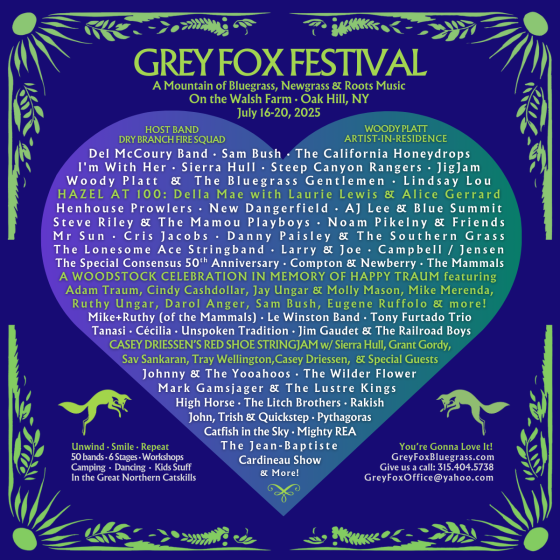
Violinist and Singer-Songwriter Anne Harris “Brings Things Up a Level” with New Album
Anne Harris is having a moment. Though many people (this writer included) are just finding out about this Midwestern violin virtuoso this year, she has been making records since 2001. With her new album, I Feel It Once Again (released May 9), Harris decided, in her words, to “bring things up a level.”
Not only is the disc getting rave reviews, it marks the first-ever violin commission in America between two Black women – Harris and luthier Amanda Ewing. The 10 songs on I Feel It Once Again range from traditionals like “Snowden’s Jig” and the closer “Time Has Made A Change” to originals like “Can’t Find My Way” and the project’s title track. Throughout, Harris remains impressive in both her vocals and her violin playing. The album was produced by Colin Linden who has worked with Bob Dylan, Rhiannon Giddens, Bruce Cockburn, and many others.
Harris is currently based in Chicago, but was actually born in rural Ohio. She took to music at a very young age, inspired by her parents’ record collection. After attending the University of Michigan’s School of Music, Harris moved to Chicago, where she delved into the city’s theater and music scenes. Now, she is about to tour with Taj Mahal and Keb’ Mo’ this summer. BGS had the pleasure of catching up with Anne Harris for a conversation about the new album, her Amanda Ewing-built violin, her influences and inspirations, and more.
To start, tell me where and when I Feel It Once Again was recorded.
Anne Harris: I did the record in Nashville. Coming out of the pandemic, I had been writing and I felt like I had a collection of songs – a pool of things that I wanted to be on my next record. I wanted to work with a producer, [but] I wasn’t sure who to work with. All my prior records had just been basement records, basically. Nothing wrong with that, but I wanted to bring things up a level. A friend of mine, Amy Helm – who is an amazing singer-songwriter in her own right – recommended Colin Linden to me.
Colin is Canadian born and raised. Incredible multi-instrumentalist [and] producer that’s made Nashville his home for many years now. Anyone [Amy] recommends I’m gonna listen to. So I started listening to some of the records he made. I got in touch with Colin and sent him, in really rough form, a big basket of songs I was considering. He really loved them and wanted to work on the record. We got the basic core of the record laid down in about a week of intense recording in Nashville and finished up with a few things remotely after that.
Is it true that you first picked up the violin as a kid after watching Fiddler on the Roof?
Yeah! My Mom took my sister and I to see the movie version of Fiddler on the Roof when we were little; I was around three. I was born and raised in Yellow Springs, Ohio. I remember being at this movie theater in Dayton for a matinee. I remember the picture of the screen – you know, this opening scene where Isaac Stern is in silhouette on a rooftop playing the overture. And [my mother] said I stood up, pointed at the screen, and yelled – as loud as I could – “Mommy! That’s what I wanna do!” She was like, “Okay, you gotta sit down and be quiet.”
She thought [it was] maybe a passing thing and that I was caught up in the drama of the music. [But] I just kept bugging her about it. So she let me do a couple of early violin camp kind of things here and there. I just had this intensity about wanting to really study it. So when I turned eight, I started studying privately with a teacher. Suzuki and classical training was sort of my background.
Tell me about the title track, which is also right in the middle of the album. What inspired “I Feel It Once Again?”
A couple of years ago, [my] friend Dave Hererro – who is a Chicago based blues guitar player. Sometimes he’ll come up with a little riff and send it my way and say, “What do you think of this?” He sent me this guitar riff, which is kind of the through line of that song. I heard it and immediately the whole song and story unfolded in my head. I wrote [it] around that guitar riff in, like, one session. I did a demo and I played it for Dave. I’m like, “Dude! I love this so much.” He’s like, “Well, do whatever you want with it!”
Writing is an interesting thing. I’m not super prolific. I’m not one of those people that’s like, “I journal every day for 13 hours!” [Laughs] You know? [I don’t] have a discipline or method other than trying to stay open to inspiration and committing to it when it happens.
[That] was the case with that song. I had the story and a picture in my mind of what that song about. Somebody musing over a loss. You know, it’s twilight and they’re finishing a bottle of wine and mourning the loss of this great love. One part of you is fine when it’s daytime and you can put on a face and you’re going about your business. But then when the curtain comes down, behind that curtain is this loss and this mourning. That’s what that song is about.
Everything looks different at 4am, doesn’t it? [Laughs]
I [also] wanted to ask you about “Snowden’s Jig.” That’s a type of music I know virtually nothing about. I know it’s a traditional.
Yes. “Snowden’s Jig” is a tune that I learned from the Carolina Chocolate Drops record Genuine Negro Jig. It was my gateway into the Carolina Chocolate Drops. I was doing errands somewhere and I had NPR on and [they] were a feature story. And it was just this mind-blowing thing.
Joe Thompson [has] been deceased for a while now. But he was one of the last living fiddlers in the Black string band tradition. They would go to his porch, learn tunes from him, and learn the history of Black string band tradition. That’s sort of how they started their group. [“Snowden’s Jig”] was on that record and they learned it from Joe.
Part of my mission as an artist is to be a bridge of accessibility through my instrument, the violin, to the Black fiddle tradition. There was a time during slavery days when the fiddle and banjo were the predominant instruments among Black players. Guitars were sort of a rarity. That was when string band music was really at its height. North New Orleans was the sort of center of Black fiddle playing. Often time, enslavers would send their enslaved people down to New Orleans to learn how to play fiddle and then come back to the plantation to entertain for white parties and balls.
You’re based in Chicago. It’s a big music city. How has living in Chicago informed your music?
Chicago is known as a workingman’s city, a working class city. There’s something very grounded about Chicago in general and that’s the reputation it has. I’m a Midwestern person [anyway], from Ohio originally. There’s something about us in the Midwest. You know, we’ll never be as cool as New York or LA! But we work our asses off. I feel that translates into the artists in this town. It’s really a place where it’s about the work.
This album apparently marks the first violin commission between two Black women. Yourself and Amanda Ewing?
Correct. Amanda Ewing. It’s the very first professional violin commission that’s been recognized in an official capacity. Amanda has a certificate from the governor of Tennessee – she’s a Nashville resident – citing her as the first Black woman violin luthier in the country.
When I first saw Amanda, it was online. The algorithm basically brought her to my phone. I saw a picture of this beautiful Black woman in a work coat, holding the violin and I about lost my mind. I was so blown away and inspired. I read her story and got in touch with her and told her, “I have to have you make a violin for me. I have to own a violin that was made by the hands of somebody that looks like me.” It never occurred to me, in all my years of playing, what the hands of the maker of my instrument might look like. That’s not an uncommon thing, but it’s sort of sad! It would never occur to me that a Black woman would be an option.
So as soon as I met her, we embarked on a commission that was funded by GoFundMe. She decided she wanted to make two [violins] so that I would have a choice. They were completed in February, a couple of months ago. [One violin] will make its official debut for a public audience on the 23rd of May. I’m gonna be playing at the Grand Ole Opry with Taj Mahal and Keb’ Mo’. I’m going on tour with them.
It’s funny, I was gonna ask you next about that tour! I noticed you had some upcoming tour dates with Taj and Keb’. I wanted to ask your thoughts on that and maybe what people can look forward to on this tour.
A friend of mine is Taj Mahal’s manager and she’s also good friends with Keb’. She said that Kevin [Keb’] had approached her looking for a violinist player for this upcoming tour. They have a new record out as TajMo called Room On The Porch. It’s their second under that moniker and it’s an amazing collaboration. Two iconic figures making beautiful music together. So she recommended me and [Keb’] had seen me before – I think when I was touring with Otis Taylor years ago. He called me and you know I’ll keep that voicemail forever!
As far as what to look forward to, it’s gonna be amazing. The opportunity to work with luminaries… I’m gonna be the biggest sponge, soaking up all of the knowledge from these giants. Taj has been influential to just about everyone on some level. He’s one of those people who’s worked with everybody and done so much. I’m just over the moon.
Photo Credit: Roman Sobus
BGS 5+5: Adam Chaffins
Artist: Adam Chaffins
Hometown: Louisa, Kentucky
Latest Album: Trailer Trash EP (released May 16, 2025)
Personal Nicknames: “Chaffins”
Genre is dead (long live genre!), but how would you describe the genres and styles your music inhabits?
I’ve considered myself a multi-genre artist from the beginning. While I feel confident identifying as a country artist, that label doesn’t capture the full range of my influences. Growing up, I listened to country alongside Top 40 hits and classic rock – those styles shaped my ear just as much. In high school, I discovered bluegrass and jazz, and during college I really dove deep into those genres and honed my craft within them.
All of those influences have filtered into my writing today and I think that’s especially clear on this new EP. Music, like culture, is becoming increasingly interconnected and multi-dimensional. It’s exciting to see more country artists exploring new spaces and I want to make music that is part of that evolution.
Which artist has influenced you the most – and how?
Speaking of multi-genre artists, Willie Nelson is a great place to start. He’s part of the foundation of country songwriting – hell, songwriting in general. His music draws from so many different influences and we wouldn’t have the classic Willie Nelson records without that breadth.
It’s tough to single out just one artist as my biggest influence, but more often than not, when I’m writing a line or delivering a phrase, I catch myself asking, “What would Willie do?” His sound has never felt forced or put on – it’s authentic because he’s lived every word of it. Beyond the music, his lessons in patience and positivity have been a huge influence on me and have played a big part in keeping me grounded and continuing to make music.
Which elements of nature do you spend the most time with and how do those impact your work?
I love the outdoors – it’s essential for my creativity. Whether I’m kayaking on the lake, hiking with my dog, or cycling down country backroads, being outside helps me reset. When I’m feeling bogged down by the ‘business’ side of music, stuck on a lyric, or just need a break from a piece I’m learning, nature gives me the space to clear my mind. It’s like a creative reset button – being in the elements helps me return with energy and perspective.
What was the first moment that you knew you wanted to be a musician?
Some of my earliest memories are of wanting to be a musician – or at least be around musicians. I had toy guitars and drum sets and would just bang away, trying to get the sounds in my head out long before I had any idea what I was doing.
One moment that really stands out happened before I could even read or write. A local DJ I was obsessed with was doing a promo at a car lot and my mom took me to meet him. I thought he was the gatekeeper to all of music. I remember scribbling on sticky notes – what I explained were the instruments and band members I wanted for my future group. He smiled, folded the notes, and tucked them into his shirt pocket with a wink, just before going back on the air.
Looking back, that moment felt like an early manifestation. Even then, I knew music was where I wanted to be – I just didn’t have the words for it yet.
If you didn’t work in music, what would you do instead?
I love to cook. When the world shut down during COVID and there were no shows to play, I got a big offset smoker trailer and started smoking whole chickens outside a locally owned grocery store. Honestly, I probably earned fans faster with barbecue than I ever have with music…
That said – it’s tough work. Tending fires inside a steel pit during a Tennessee summer isn’t for the faint of heart. But then again, neither is rolling around the country in a van playing songs for strangers. I guess one just happened to be the dream I had first. I still cook and smoke meat whenever I can and, if I weren’t making music, I could absolutely see myself doing that full-time.
Photo Credit: Natia Cinco
